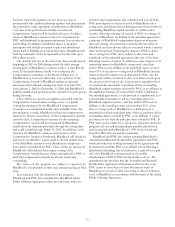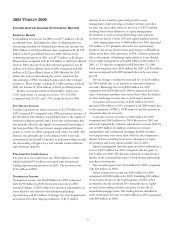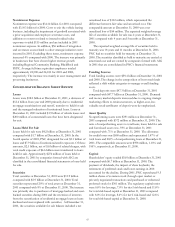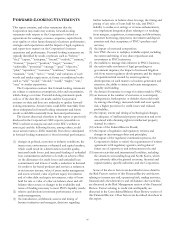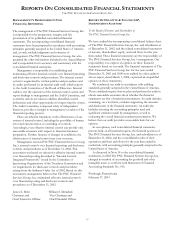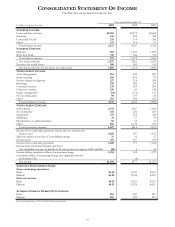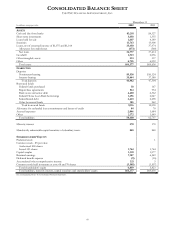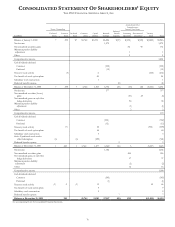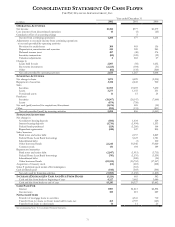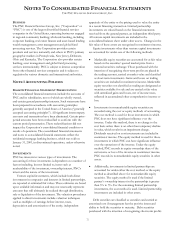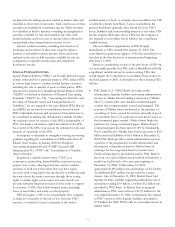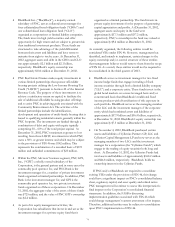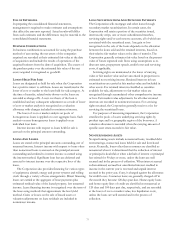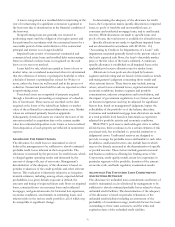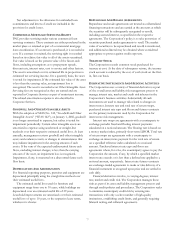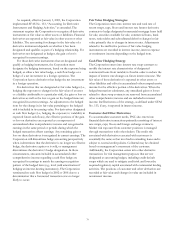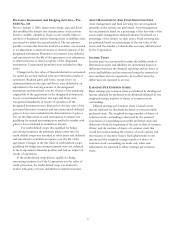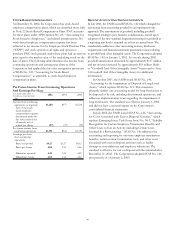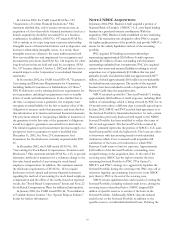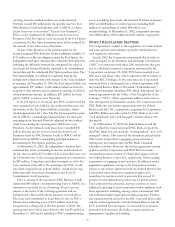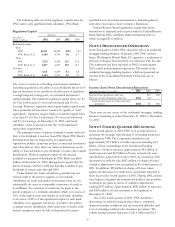PNC Bank 2002 Annual Report Download - page 75
Download and view the complete annual report
Please find page 75 of the 2002 PNC Bank annual report below. You can navigate through the pages in the report by either clicking on the pages listed below, or by using the keyword search tool below to find specific information within the annual report.73
are placed in the trading account, carried at market value and
classified as short-term investments. Gains and losses on these
securities are included in noninterest income. Debt securities
not classified as held to maturity or trading are designated as
securities available for sale and carried at fair value with
unrealized gains and losses, net of income taxes, reflected in
accumulated other comprehensive income or loss.
Interest on debt securities, including amortization of
premiums and accretion of discounts using the interest
method, is included in interest income. Gains and losses
realized on the sale of debt securities available for sale are
computed on a specific security basis and included in
noninterest income.
SPECIAL PURPOSE ENTITIES
Special Purpose Entities (“SPEs”) are broadly defined as legal
entities structured for a particular purpose. PNC utilizes SPEs
in various legal forms to conduct normal business activities
including the sale or transfer of assets to third parties. SPEs
that meet the criteria for a Qualifying Special Purpose Entity
(“QSPE”) as defined in Statement of Financial Accounting
Standards (“SFAS”) No. 140, “Accounting for Transfers and
Servicing of Financial Assets and Extinguishments of
Liabilities,” are not required to be consolidated. SPEs that are
not QSPEs are reviewed for consolidation based on each
SPE’s individual structure and operations. General factors to
be considered in making this determination include whether
the majority owner (or owners) of the SPE is independent of
PNC, has made a substantive capital investment in the SPE,
has control of the SPE, or possesses the substantive risks and
rewards of ownership of the SPE.
In response to demands to strengthen existing accounting
guidance regarding the consolidation of SPEs and other off-
balance sheet entities, in January 2003 the Financial
Accounting Standards Board (“FASB”) issued FASB
Interpretation No. (“FIN”) 46, “Consolidation of Variable
Interest Entities”.
In general, a variable interest entity (“VIE”) is a
corporation, partnership, limited liability corporation, trust,
grantor trust or any other legal structure used to conduct
activities or hold assets that either does not have equity
investors with voting rights that can directly or indirectly make
decisions about the entity’s activities through those voting
rights or similar rights or has equity investors that do not
provide sufficient financial resources for the entity to support
its activities. A VIE often holds financial assets, including
loans or receivables, real estate or other property.
FIN 46 requires a VIE to be consolidated if the company
is subject to a majority of the risk of loss from the VIE's
activities, is entitled to receive a majority of the entity's
residual returns or both. A company that consolidates the VIE
is called the primary beneficiary. Upon consolidation, the
primary beneficiary generally must record all of the VIE’s
assets, liabilities and noncontrolling interests at fair value. FIN
46 also requires disclosures about VIEs that the company is
not required to consolidate but in which it has a significant
variable interest.
The consolidation requirements of FIN 46 apply
immediately to VIEs created after January 31, 2003. The
consolidation requirements apply to VIEs that existed prior to
that date in the first fiscal year or interim period beginning
after June 15, 2003.
Based on a preliminary review of the provisions of FIN 46,
it is reasonably possible that PNC and/or BlackRock will hold
a significant variable interest in certain existing VIEs that
would require the Corporation to consolidate these entities in
the third quarter of 2003. A description of these existing VIEs
follows:
• PNC Bank, N.A. (“PNC Bank”) provides credit
enhancement, liquidity facilities and certain administrative
services to Market Street Funding Corporation (“Market
Street”), a multi-seller asset-backed commercial paper
conduit that is independently owned and managed. The
activities of Market Street are limited to the purchase of,
or making of, loans secured by interests primarily in pools
of receivables from U.S. corporations that desire access to
the commercial paper market. Market Street funds the
purchases by issuing commercial paper. Market Street’s
commercial paper has been rated A1/P1 by Standard &
Poor’s and Moody’s. Market Street had total assets of $3.0
billion and total liabilities of $3.0 billion at December 31,
2002. PNC Bank provides certain administrative services,
a portion of the program-level credit enhancement and
the majority of liquidity facilities to Market Street in
exchange for fees negotiated based on market rates.
Credit enhancement is provided in part by PNC Bank in
the form of a cash collateral account which is funded by a
credit loan facility with a five-year term expiring on
December 31, 2004. At December 31, 2002,
approximately $96 million was outstanding on this facility.
An additional $287 million was provided by a major
insurer. Also at December 31, 2002, Market Street had
liquidity facilities available supporting individual pools of
receivables totaling $3.9 billion, of which $3.2 billion was
provided by PNC Bank. As Market Street’s program
administrator, PNC received fees of $13.9 million for the
year ended December 31, 2002. Commitment fees related
to PNC’s portion of the liquidity facilities amounted to
$7.5 million for 2002. PNC holds no ownership interest in
Market Street.


